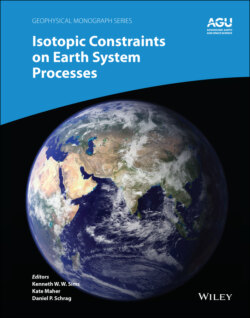Читать книгу Isotopic Constraints on Earth System Processes - Группа авторов - Страница 59
Model Applied to the Rhyolite‐Phonolite Couples
ОглавлениеThe rhyolite‐phonolite diffusion couple spans a broad range of melt compositions. Although the diffusion coefficients are expected to be sensitive to melt composition across this range, we assume and Db are constant. We also treat the diffusion couple as infinite with respect to SiO2 even though we see some uphill diffusion of SiO2 at the ends of the couple in the 2.5 hour run. This, however, may just be due to mass balance and dilution effects caused by the faster diffusing components. For the faster diffusing K2O and CaO components, the diffusion couple is not treated as infinite; i.e., ∂C/∂x = 0 at the boundaries.
Despite the many simplifying assumptions that are needed to distill a general multicomponent diffusion problem down to a three‐parameter model (Cf, Db, and ), the modified EBD model is capable of reproducing the sign and magnitude of uphill diffusion in the K2O and CaO profiles (Fig. 2.7a–f). The positive Cf for CaO implies that CaO partitions into mafic liquids whereas the negative Cf for K2O implies that K2O partitions into felsic liquids, which is consistent with the known partitioning behavior of these two oxide components (Ryerson & Hess, 1978; Watson, 1976). The misfit on the ends of the CaO profiles suggest that the activity of CaO depends on melt components in addition to SiO2. The next level of complexity would be to include the alkali components in the activity‐composition model for CaO.
The goodness‐of‐fit for the K2O profile is even less satisfying due to the unusual shape of the measured K2O profile, which is nearly flat on the mafic side and linear to nearly convex on the felsic side. This shape cannot be reproduced using the simplified EBD models discussed herein. Nevertheless, the inferred is a reasonable average value, being somewhat overestimated on the rhyolite side and somewhat underestimated on the phonolite side. A better fit could be obtained by casting as a function of SiO2 concentration (Richter et al., 2003, 2009; Watkins et al., 2009) or by introducing some other additional ad hoc complexity into the model. We did not undertake such efforts because the calculated concentration profiles provide an adequate description of the K2O fluxes to be used as a baseline for modeling the isotope ratio profiles.
Figure 2.7 The modified EBD model applied to the data. Top panels: SiO2 diffusion is well‐approximated as effective binary in an infinite medium. Middle panels: Both CaO and K2O exhibit uphill diffusion, which is attributed in the model to transient partitioning between high‐silica and low‐silica liquids. Bottom panels: Despite the simplifying assumptions, the model captures the sign and magnitude of diffusive isotope effects.
